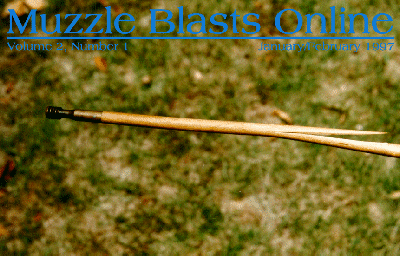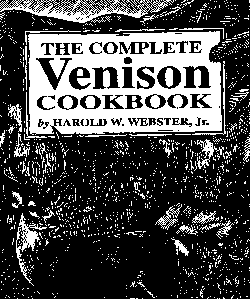|
Muzzle Blasts Online |
|
...for the muzzleloading enthusiast |
|
The muzzleblasts.com domain, subdomains, content, etc., are neither affiliated with the NMLRA nor its paper magazine Muzzle Blasts |
|
Muzzle Blasts Online |

|
|
|
|
|
|
Elegant Venison
ISBN 0937552-70-4

|
Reindeer are believed by many to be one of the first domesticated deer. A ninth century letter from Norway's King Ottar to Alfred the Great mentioned his fine herd of over 600 reindeer. Deer farms have existed in China since about 2,000 B.C. Varro (116-27 B.C.) wrote ``Nowadays, people enclose many acres within walls so as to keep numbers of wild boars and roes... [these game reserves] retain their old name of leporia for not only are hares enclosed in its woods, as used to be the case on an acre or two of land, but also stags and roes on many acres.''
In medieval times, cattle eventually became more important to feed troops than deer because cattle provided a meat that is high in fat content which is essential to soldiers who needed to stay warm during cold winters. For the same reason, beef became the staple food for peasants, while the leaner venison became a ``royal food'' for the landed aristocracy who lived in warm and protected homes. In the Doomsday Book, there are 31 deer parks listed at the end of the 11th century. Census of world deer farms indicate that over 2,215,700 deer are under farm management in the world today. And, it is estimated that the world population of farm raised deer will approach 8,000,000 within the next four years.
Because of unregulated recreational and market hunting, the North American whitetail deer was well on its way to extinction at the turn of the century. In 1880, 70,000 deer were killed in Michigan alone. Subsistence farmers and sportsmen took 4,000, compared to over 60,000 by market hunters. An estimated five million pounds were shipped out of state. As a result, a bill restricting the sale of Michigan game meat in other states became law in 1881. Across the country, legislation barring market hunting became the rule rather than the exception. The Lacy Act of 1900, put an end to the market hunting industry by making it a federal crime to ship game across state lines. And, in 1908, the United States government issued an Extension Bulletin which provided prospective deer farmers with guidelines for building and managing a deer farming ranch.
As a direct result of the enactment of hunting regulations and legislation, it is estimated that there are now 52 times as many deer in the United States as there were in 1900. It is believed that there are over 26 million whitetail deer in North America today; more than were present when Christopher Columbus arrived in 1492.
In Mississippi, it is estimated that there are over 1,750,000 deer today. In 1995, over 300,000 deer were harvested in Mississippi by over 175,000 licensed deer hunters.
In Colonial America, venison was the primary source of large game meat for the family table. The colonial cook knew hundreds of ways to prepare and preserve game. The most prized delicacy of all, was venison. Early Americans had few domesticated animals. These animals were far too precious to be killed for the table. A typical 1746 American Colonial venison recipe was ``Sauce Espagnole for Roast Venison'' as described in Menons cookbook, La Cuisiniere Bourgeois. To celebrate Lincoln's second inaugural dinner, the menu featured ``Roast Venison with Herb Crust.''
Today, many cooks are afraid to prepare venison because they have heard about its alleged dryness, toughness, and unpleasant flavor. Cooking your venison is very easy, once a few basic harvesting and cooking procedures have been learned.
If you do not hunt or do not have a ready access to domestic venison, you can find many firms that raise and ship farm raised venison. Most of these firms have home pages on the internet. Since it is illegal to buy, sell, or trade deer species that are indigenous to the United States, these ranchers have imported European, Australian, and Oriental deer and bred them specifically for this market. These suppliers are USDA inspected and they will be able to provide you with the exact cuts of venison that you require. Some of these firms also market prepared venison products. Other firms have fresh venison air shipped daily from New Zealand and Europe.
Venison is a fine, delicately textured, virtually fat free meat. Many cuts are very similar to veal. Other cuts, such as chops, look like pork. Round steaks, although smaller, have the appearance of beef. Stew meat and ground venison also resemble beef. Even though many cuts of venison look like other meats, venison has one overall characteristic that distinguishes it from other meats. Venison is a low or no fat meat, and during cooking, it needs additional moisture.
Venison responds best to slow and very moist cooking. Fast frying can turn a thinly cut chop or steak into something closely resembling harness leather. Dry roasting will give you a piece of very dry meat. Frying venison should be done very quickly. Brown the outside, but leave the inside less than medium (preferably medium-rare). Many outstanding recipes call for quickly browning, then slowly cooking in a gravy over a very low heat.
For dry roasting, larding (inserting into the venison thin strips of moist meat, such as bacon, salt pork, or beef/pork fat) and/or wrapping the roast with moist meats such as bacon or salt pork will provide moisture. These moisturizing techniques are almost a must. Ground venison for burgers or sausages, and other ground venison recipes will need to have a small amount of beef suet, pork fat, bacon, or mushrooms ground in with the venison.
As with other types of meat, the most tender cuts come from the muscle groups that are used the least. The neck is one of the toughest cuts because it is in almost constant motion from either grazing or looking around. The most tender muscle group is the little tenderloin. And, it is closely followed by the long backstrap. Venison chops, cut from the backbone and which contain the tenderloin and/or the backstrap are one of the finest cuts of meat you can find. Fore and hindquarters can be used to make roasts or large steaks. Although somewhat less tender than the backstrap, fine steaks can be cut from the top of the quarters. These quarter muscle groups need care to prevent toughening while cooking. When they are used as large roasts, slow cooking to no more than medium and larding with moist meats will prevent drying out during the dry roasting process.
Slow cooking in a crock pot will make your venison roast as tender as any beef you have ever eaten.
Chops should be cut thicker than one would cut from pork. Round steaks can be cut the same thickness as one would cut from beef. Quick browning and very slow cooking for chops and steaks make for outstanding meals.
For the purist or primitive at heart, making jerky out of venison is an outstanding way to preserve the meat for long periods of time. Home canning of venison is also easy.
Native Americans and early settlers harvested deer in a way that we did not re-discover until the early 1980's. They quietly stalked or waited for their game. With one well-placed arrow or ball, the deer was harvested quickly and cleanly. This method of hunting deer produced venison that was mild flavored and sweet smelling.
When I first began trying to cook venison, I could not stand the ``wild taste.'' I wondered, if venison tastes this bad, how could my early Mississippi ancestors stand to eat it? I knew that when Jacob Curry settled in the Spanish Territory, of what is now Mississippi, in the late 1790's, venison would have been the main-stay in his family's diet.
While visiting with old family friends in Leakesville, Mississippi, I have had occasion to be invited over for Sunday dinner or barbecues. The venison that I was served was glorious.
What I didn't know about the venison I was served was that a few of these old Greene County Scots and Frenchmen would occasionally ease out to the woods and harvest a deer in the quiet of the early evening. This was the hunting that they really enjoyed. At first, they didn't talk much about this to me. This was the venison they served to their families and to special invited guests.
I don't remember anyone telling me how the venison used in those particular recipes was harvested. When I would ask what made the venison taste so good, I would be blessed with sympathetic smiles and mumbled replies. It wasn't time for me to know the secret. For the time being, I would have to be satisfied with little real information. Hunting magazines, large generic cookbooks, or general game cookbooks did provide a few basic recipes. These recipes featured descriptions of complicated marinades that were promoted as a means of masking the ``wild taste'' of venison. I was not a very successful venison chef. In time, the secrets would be shared with me, my adventure would begin and my attitude towards venison was changed forever.